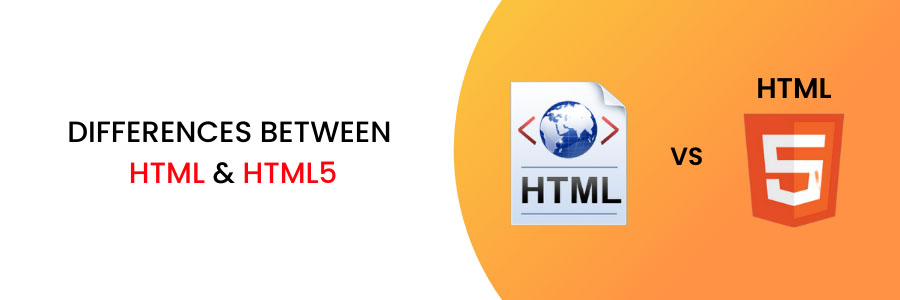The Differences Between HTML and HTML5

HTML stands for Hyper Text Markup Language. It is used to create web pages with the help of a markup language. HTML is an abbreviation for Hypertext Markup Language. The link between web pages is defined by hypertext. To define the text document within the tag that defines the structure of web pages, a markup language is used.
Differences Between HTML and HTML5
The most extensively used markup language for building web pages and apps is HyperText Markup Language (HTML). It consists of predefined elements and tags for tagging material and specifying page structure.
HTML5 is the most recent version of HTML and enables more capabilities like as multimedia, new tags and components, and new APIs.
We’ll discuss the differences between HTML and HTML5, as well as the benefits of HTML5 for both developers and end users. In addition, we’ll address the most common HTML5 queries and provide an HTML5 cheat sheet to aid the learning process go more smoothly.
What Is HTML and How Does It Work?
The World Wide Web’s primary language is HTML (WWW). It is used by web developers to create text, hyperlinks, and multimedia assets for online pages.
HTML 5.2 is the most recent version, which was updated in 2017. More historical HTML milestones can be seen in the chart below.
To describe text structures, HTML employs a variety of tags, including those for headers, tables, and paragraphs. The and formula is used to define each tag. The tags are referred to as “opening” and “closing,” respectively.
To convert the text style to italic, we might use type your content here. These tags will be used by the browser to produce the content, which will subsequently be displayed on the screen.
It’s important to note that HTML is a static language, thus it can’t be used to construct a dynamic or interactive web page. It solely affects the web page’s static elements, such as the content header, footer, and picture position.
You’ll need to mix HTML with at least two front-end languages to create an interactive website: CSS stands for Cascading Style Sheets.
What is HTML5 and how does it work?
HTML5 is the most recent version of the HyperText Markup Language, and it now includes multimedia, tags, and elements, as well as better document markups and new APIs.
Difference Between HTML and HTML 5
There are many differences between HTML and HTML5 which are discussed below:
| Feature | HTML | HTML5 |
| Definition | HyperText Markup Language (HTML) is the standard markup language for creating, structuring, and displaying web pages. | HTML5 is a markup language that is the fifth and latest major version of HTML. It includes newly added features, tags, and elements. |
| Multimedia support | HTML does not provide native audio and video support. | HTML5 provides native audio and video support. |
| Vector graphics support | HTML only supports vector graphics if used in conjunction with different technologies like Flash, VML, or Silverlight. | HTML5 supports SVG (Scalable Vector Graphics), Canvas, and other virtual vector graphics. |
| Inline MathML and SVG in text | HTML allows it with restricted use. | HTML5 allows it. |
| Shapes | HTML doesn’t allow users to draw shapes such as circles, triangles, and rectangles. | HTML allows users to draw shapes such as circles, triangles, and rectangles. |
| Data storage | HTML only uses browser cache and cookies to store data temporarily. | HTML5 uses web SQL databases, local storage, and application cache for storing data temporarily. |
| Threading | JavaScript and browser interface run in the same thread. | JavaScript and browser interface run in separate threads. |
| Document type declaration | Longer document type declaration. | Shorter document type declaration. |
| Character encoding | Longer character encoding declaration. Uses the ASCII character set. | Shorter character encoding declaration. Uses the UTF-8 character set. |
| Browser support | Compatible with almost all browsers. | Only compatible with newer browsers, considering there are many new tags and elements which only some browsers support. |
| Built based on Standard Generalized Markup Language (SGML) | Yes. | No. This means it has improved parsing rules providing enhanced compatibility. |
HTML5 has undergone the following changes in addition to the capabilities listed above:
- isindex, noframes, acronym, applet, basefont, dir, font, frame, frameset, big, centre, strike, and tt were all eliminated.
- Dates and times, email, phone, range, tel, url, search, colour, and datalist are among the new form controls.
- Video, navigation, aside, progress, canvas, section, metre, and time are just a few of the new features.
- New APIs include drag-and-drop capabilities, browser history manipulation, and reading and locking screen orientation status, among other features.
- Async, manifest, sandbox, srcdoc, and reversed are among the new characteristics.
- Hidden, role, spellcheck, and translate are new global properties.
We hope you found our HTML vs HTML5 article useful. Best wishes.
